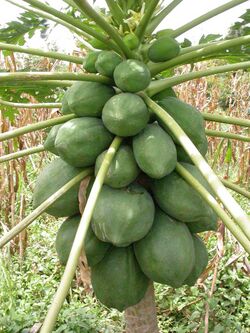Biology:Papaya lethal yellowing virus
| Papaya lethal yellowing virus | |
|---|---|
| Virus classification | |
| (unranked): | Virus |
| Realm: | Riboviria |
| Kingdom: | Orthornavirae |
| Phylum: | Pisuviricota |
| Class: | Pisoniviricetes |
| Order: | Sobelivirales |
| Family: | Solemoviridae |
| Genus: | Sobemovirus |
| Species: | Papaya lethal yellowing virus
|
Papaya Lethal Yellowing Virus (PLYV) is an isometric viral plant pathogen, tentatively assigned to the genus Sobemovirus,[1] that causes lethal yellowing disease of the papaya plant.[2]
The virus infects only Carica papaya, Jacaratia heterophylla, J. spinosa, Vasconcellea cauliflora, V. monoica and V. quercifolia, all from the papaya family Caricaceae.[3] It is only found in Northeastern Brazil and has no confirmed biological vectors.[4] PLYV consists of a 36 kDa capsid protein[3] and a single-stranded RNA genome 4145 nt in length,[1] and causes progressive leaf yellowing and greenish circular spots on the fruits.[4] Control of this virus is of economic importance in Northeast Brazil, as 60% of Brazil’s papaya production occurs there.[5]
Hosts and symptoms
As the name implies, PLYV is very host-specific. In an inoculation study, the virus only infected members of the papaya family Caricaceae, whereas other species (Chenopodium amaranticolor, C. murale, C. quinoa and Nicotiana benthamiana) were not infected.[3]
The signs of the virus begin to become visible when the leaves at the top of the plant begin turning yellow and eventually fall off.[6] This usually occurs in the upper third of the canopy and death of the plant usually occurs soon after the leaves wilt and die.[3] The fruit in some studies was found to be delayed in the ripening process and the pulp turns hard.[3]
Disease cycle
PLYV was first recognized in the 1980s,[7] and has always been restricted to a relatively small geographical area. Therefore, it is not likely that the virus has been introduced to other regions. It is more likely that the virus was present in wild hosts and jumped to papaya plants once this crop became widely cultivated in that area (i.e. northeastern Brazil).[5]
While no biological vector is known for PLYV is known, it is known to be spread by human actions, including contaminated hands, agricultural tools, soil, and contaminated water.[8] The virus can be detected on the surface of seeds of infected fruits, but it is not detected in the embryo or in seeds harvested from infected roots.[3] As a result, the virus is likely spread by infected plantlets or growers using contaminated tools.[3]
PLYV is very stable and in one experiment was detected in dried roots and leaves maintained at room temperature up to 120 days.[8] This shows that the virus has high stability in non living plant tissues, which further explains how it can be spread by human actions.[8] PLYV has a thermal inactivation point of 80 °C.[8]
Management
PLYV can be controlled in various ways. These include use of virus-free plantlets, eradication of virus-infected plants, disinfecting agricultural tools that have been exposed to PLYV, and adopting growing techniques that reduce human-assisted transmission of the virus.[3]
Importance
Control of the virus is economically important in Brazil , which contributes about 25% of world papaya production,[6] and where the papaya crop ranks above strawberries and below grapefruit in total production.[9] The risk of mechanical transmission is high because trees are grown at a high density of 1,500 to 2,500 per hectare in commercial production.[6]
See also
References
- ↑ 1.0 1.1 Pereira, AJ; Alfenas-Zerbini, P; Cascardo, RS; Andrade, EC; Murilo Zerbini, F (2012). "Analysis of the full-length genome sequence of papaya lethal yellowing virus (PLYV), determined by deep sequencing, confirms its classification in the genus Sobemovirus". Archives of Virology 157 (10): 2009–2011. doi:10.1007/s00705-012-1384-x. PMID 22743825. http://www.locus.ufv.br/handle/123456789/19583.
- ↑ Silva, A.M.R.; Kitajima, E.W.; Souza, M.V.; Resende, R. (1997). "Papaya lethal yellowing virus: a possible member of the Tombusvirus genus.". Fitopatologia Brasileira (22): 529–534.
- ↑ 3.0 3.1 3.2 3.3 3.4 3.5 3.6 3.7 Lima, J.A.A.; Nascimento, A. K. Q.; Lima, R. C. A.; Purcifull, D. E. (2012). "Papaya lethal yellowing virus.". The Plant Health Instructor. doi:10.1094/PHI-I-2013-0123-01.
- ↑ 4.0 4.1 Nascimento, A.K.Q.; Lima, J.A.A.; Nascimento, A.L.L.; Beserra, E.A. Jr; Purcifull, D.E. (22 June 2010). "Biological, physical, and molecular properties of a Papaya lethal yellowing virus isolate". Plant Disease 94 (10): 1206–1210. doi:10.1094/PDIS-11-09-0733. PMID 30743613.
- ↑ 5.0 5.1 Daltro, Cleidiane B. Daltro; Álvaro J. Pereira; Renan S. Cascardo; Poliane Alfenas-Zerbini; José Evando A. Bezerra-Junior; José Albérsio A. Lima; Francisco Murilo Zerbini; Eduardo C. Andrade (2012). "Genetic variability of papaya lethal yellowing virus isolates from Ceará and Rio Grande do Norte states, Brazil". Tropical Plant Pathology 37 (1): 37–43. doi:10.1590/s1982-56762012000100004. http://www.scielo.br/pdf/tpp/v37n1/v37n1a04.pdf.
- ↑ 6.0 6.1 6.2 Loebenstein, Gad (2003). Virus and Virus-like Diseases of Major Crops in Developing Countries (Developments in Cardiovascular Medicine). Dordrecht, The Netherlands: Kluwer Academic Publishers. pp. 498–501. ISBN 1402012306.
- ↑ Ventura, S.A.M.H. Naqvi. Vol., ed (2004). Diseases of Fruits and Vegetables: Diagnosis and Management. Springer. pp. 246–248. ISBN 1402018231. https://books.google.com/books?id=ZiY9ZDZ_QUUC&q=ventura+diseases+of+fruits+and+vegetables:+diagnosis+and+management&pg=PA267.
- ↑ 8.0 8.1 8.2 8.3 do Nascimento, Ana Lúcia Lopes; José Albersio de Araujo Lima; Aline Kelly Queiroz do Nascimento; Maria de Fátima Barros Gonçalves (2010). "Serology and surviving characteristics of Papaya lethal yellowing viru". Revista Ciência Agronômica 41 (3): 448–455. http://www.scielo.br/pdf/rca/v41n3/v41n3a18.pdf. Retrieved 25 October 2013.
- ↑ Gonsalves, Dennis (1998). "Control of Papata Ringspot Virus in Papaya: A Case Study". Annual Review of Phytopathology 36: 415–437. doi:10.1146/annurev.phyto.36.1.415. PMID 15012507.
Wikidata ☰ Q16987315 entry
 |


